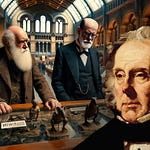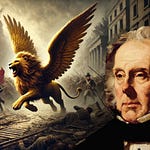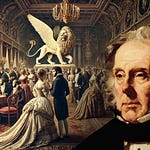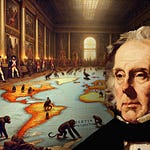Episode 03 - The Venetian Takeover of England: A 200-Year Project
Episode 05 - Bestial British Intelligence Of Shelburne and Bentham
Episode 06 - America's 'Young America' Movement: Slaveholders, B'nai B'rith, and the British Strategy
Episode 07 - Palmerston Launches Young Turks to Permanently Control the Middle East
Episode 09 - Jim Crow, a Cultural Weapon in the Hands of the Confederacy
In the mid-19th century, the American “Young America” movement, tied intricately to the institution of slavery, reveals the profound extent of British interference in U.S. politics. This interference spanned strategic manipulation, covert alliances, and sustained support of Confederate causes to fracture and control American unity. It’s an account of secret societies, high-stakes espionage, and persistent efforts by British political strategists to destabilize the United States from within.
🇬🇧 British Influence: A Deep-Rooted Conspiracy
From the onset of European meddling in American affairs, one foreign interest above all aimed to pull the strings: Britain. The British government, guided by foreign ministers such as Lord Palmerston, saw its greatest threat not only in America’s democratic ideals but also in its potential to upend the British Empire’s dominance. Thus, by the 1840s, Palmerston set in motion a plan to use multiple groups within the U.S. to bring down this growing power. In this vein, he created what would become known as Zionism and strengthened the existing framework of Freemasonry as a channel to push forward pro-British agendas.
In America, B’nai B’rith—a group started under the auspices of Freemasonry—was handpicked to operate as a covert front for British interests, launching the “Young America” movement as a platform to push pro-slavery and anti-Union sentiment. The British needed access to the hearts and minds of those who could be led to secessionism. By nurturing loyalty to secret societies and strategic factions, Britain inserted its influence into the minds of American intellectuals, powerful family dynasties, and newspapers alike, all of which would be molded into agents of British will.
🗣 Young America and the Idea of Controlled Revolutions
America was already struggling with a divided identity: on the one hand, a fledgling democracy with lofty ideals of unity and freedom, and on the other, a young nation still shackled by the institution of slavery. Britain, foreseeing the divisive potential of the slavery debate, fostered the “Young America” movement, which idealized revolutionary action and violent change under the guise of spreading “freedom.” But this concept of freedom was distorted; rather than true liberation, “Young America” advocated pro-slavery, Southern-secessionist ideals, making its followers unwitting pawns in the British campaign to break apart the United States.
Young America’s proponents, many tied to Scottish Rite Freemasonry and B’nai B’rith, called for freedom that paradoxically upheld slavery. For Britain, it was the perfect storm: a movement that appeared American at its surface, but which quietly served to destabilize the United States by driving a wedge between its Northern and Southern factions.
🔍 Confederate Sympathizers: A Covert Network Unmasked
The Young America movement’s allegiance to Southern interests was hardly accidental. Its leaders and operatives maintained close ties to Confederate sympathizers and often engaged in espionage on behalf of the Confederacy. Prominent figures, many of whom were also members of B’nai B’rith or Scottish Rite Freemasonry, played an instrumental role in covertly supporting secessionist causes. Judah Benjamin, a prominent leader in the Confederacy, was a key actor in this scheme. His Confederate networks extended deep into the North, including into Canadian banks that served as outposts for Confederate funds.
This vast network of Confederate sympathizers and operatives enabled them to coordinate vital logistics and communications in support of Confederate forces. As these networks expanded, so did the danger they posed to the Union’s war effort, creating a subversive internal threat that would linger even after the Civil War ended.
🏴 Secret Societies: Freemasonry’s Role in Confederate Alliances
Scottish Rite Freemasonry served as an almost invisible thread binding together the pro-slavery and secessionist factions within America. Figures such as Albert Pike, an influential Freemason and later a Confederate general, used the cover of Masonic lodges to orchestrate and support Confederate interests. This connection was critical to ensuring the survival and spread of pro-slavery ideologies across both American and British circles.
The Freemason lodges served as channels for British influence, where Pike and his cohorts, including members of the B’nai B’rith, crafted plans to expand the reach of slavery beyond the United States, aiming to annex territories in the Caribbean and Latin America. By leveraging Masonic principles, Pike and his associates perpetuated a powerful, secretive coalition that drove secessionist fervor to unprecedented heights.
📜 B’nai B’rith and Anti-Union Sentiment
As British influence cemented itself within the “Young America” movement, the B’nai B’rith evolved from its origins as a Masonic-like society into a more potent political force, firmly entrenched in the fight against Union efforts. The B’nai B’rith network stretched across Northern states, even as its members espoused Copperhead ideals and anti-Union sentiments that threatened to undermine Northern morale during the Civil War. Leaders such as Simon Wolf and Benjamin Peixotto, who held positions within B’nai B’rith, were active in the Copperhead movement, backing pro-Confederate propaganda, and they maintained ties with known Southern sympathizers and spies.
Even after the war ended, B’nai B’rith members continued to resist the federal government’s Reconstruction efforts, aligning themselves with figures like Albert Pike in fostering white supremacist sentiments across Southern states.
💰 The Financing of Division: Rothschild Influence in America
In its strategy to fracture America, Britain relied on financial backers like the Rothschild family. In the U.S., August Belmont—a close associate of the Rothschilds—funneled funds to support pro-secessionist causes. As a political agent, Belmont wielded considerable influence within the Democratic Party, bankrolling propaganda and anti-Union projects that aimed to cripple Lincoln’s presidency. With this strategic financial support, British interests reached into the very heart of America’s political landscape, spreading the influence of British banking power across the continent.
🔒 John Wilkes Booth, the Lincoln Assassination, and Espionage
The assassination of Abraham Lincoln remains a singular event in American history, but few know of the deep ties between Lincoln’s assassin, John Wilkes Booth, and the British-Confederate intelligence network. Booth’s assassination plot was not the isolated act of a lone gunman but part of a larger Confederate scheme. Among Booth’s associates were prominent B’nai B’rith members like Simon Wolf, who met with Booth mere hours before Lincoln’s assassination.
Evidence later discovered included a coded message in Booth’s trunk that matched a codebook found in the office of Confederate leader Judah Benjamin, reinforcing the ties between Lincoln’s murder and the broader British-led Confederate espionage effort. Booth’s actions that night were but one outcome of a long-standing campaign to fracture American unity at its highest level.
🕯 The Ku Klux Klan and the Southern Freemasonic Network
After the Civil War, former Confederate leaders, spurred by their Masonic allegiances, redirected their energies toward maintaining white supremacy. Albert Pike, who had been instrumental in Confederate strategies, co-founded the Ku Klux Klan to counteract the influence of Reconstruction. Pike’s Klan engaged in terror tactics against newly freed blacks and pro-Union whites, setting the tone for racial violence that would span decades.
B’nai B’rith leader Abraham Frankland joined Pike in furthering these post-war agendas, solidifying the influence of the Southern Masonic network on the Ku Klux Klan’s founding principles. Pike’s Klan headquarters in Memphis became a central hub for Klan activity, a testament to the continuing influence of Freemasonic networks.
📰 Northern Media and Anti-Black Rhetoric
While Southern Masonic influence worked to suppress black Americans in the South, Northern media figures with links to B’nai B’rith pushed anti-black policies in the North. Adolph Ochs, who would later acquire the New York Times, used his platform to propagate anti-black editorials that supported Jim Crow laws and stymied progress in black voting rights. This two-front approach—Southern terror and Northern propaganda—ensured that the gains won during the Civil War would face resistance from all sides, leading to entrenched racial segregation that persisted well into the 20th century.
Conclusion
From the Civil War to the post-war period, British and Confederate interests wove a network of secret societies, economic alliances, and espionage efforts that rippled through every layer of American society. Figures like Albert Pike and Simon Wolf, bolstered by the B’nai B’rith and the Scottish Rite, maintained British interests by manipulating America’s slavery-driven divide, bringing the country to the brink of fracture. The result was a nation torn by racial violence, weakened by foreign influence, and forever changed by the Civil War’s ideological scars.
📜 Early British Influence and Zionism
1840: British Foreign Minister Lord Palmerston directs diplomats to take Jewish communities under British protection, positioning Britain as the “natural guardian of the Jews.” This move serves British geopolitical interests, granting them influence over Jewish communities in the Middle East and Russia.
🏛 Founding of B’nai B’rith
1843: B’nai B’rith is officially founded in New York as a Masonic-style secret society. British interests reportedly back the organization, aiming to influence Jewish communities and create a political faction aligned with British strategy.
⚖ Young America Movement Gains Momentum
1845: Edwin DeLeon, from a pro-slavery family in South Carolina, promotes the “Young America” movement, encouraging revolutionary ideals and violent expansionism. This movement pushes pro-slavery and anti-Union sentiments in alignment with British interests.
🇲🇽 U.S.-Mexico War as a Prelude
1846-1848: The U.S.-Mexico War, partly promoted by Young America ideologues, results in territorial expansion but is criticized by Abraham Lincoln as a pro-slavery conspiracy. The war serves as an early testing ground for Young America’s aggressive expansionist ideals.
🔗 B’nai B’rith and Freemasonry Expand Southward
1854-1860: B’nai B’rith and Scottish Rite Freemasonry, led by figures like Isaac M. Wise and Killian Van Rensselaer, spread along the Mississippi Valley, establishing pro-slavery, anti-Union networks from Ohio to Louisiana. The Knights of the Golden Circle, a pro-secessionist and militant group, also grows in influence during this period.
💰 British Financial Backing and Confederate Ties
1850s: August Belmont, a Democratic Party boss and Rothschild representative, funds pro-Confederate projects, backing the Knights of the Golden Circle and other anti-Union initiatives to serve British objectives.
🕵 Espionage Networks in Action
1861-1865 (Civil War): During the Civil War, B’nai B’rith members like Simon Wolf operate as Confederate spies, collaborating with British and Confederate networks. Figures such as Albert Pike and Judah Benjamin utilize Scottish Rite lodges to coordinate espionage and Confederate support.
⚔ Copperhead Movement and Anti-Union Agitation
1863: Isaac Wise, B’nai B’rith leader, runs on the Copperhead anti-Union ticket in Ohio, further promoting pro-Confederate sentiment in Northern states.
🎭 Lincoln Assassination and British Confederate Links
1865 (April 14): John Wilkes Booth assassinates President Abraham Lincoln. Booth, connected to B’nai B’rith and Confederate spies, uses funds from Confederate sources, including the Montreal bank used by Judah Benjamin. A coded document in Booth’s possession ties him to Benjamin’s Confederate intelligence.
⚔ Post-War Southern Freemasonry and the KKK
1865 (Post-War): Albert Pike and Abraham Frankland, both Freemasons, establish the Ku Klux Klan in Tennessee, using Masonic influence to suppress black voting and Reconstruction efforts across the South. Memphis becomes a Klan stronghold.
📰 Media Influence and Northern Anti-Black Campaigns
Late 1800s: Adolph Ochs, connected to B’nai B’rith, uses the New York Times to promote anti-black editorials, aligning Northern media with Jim Crow policies that mirror Klan sentiments in the South.
🔎 Legacy of British Influence and Division
20th Century Onward: The effects of British-backed divisions persist, with Freemasonic networks, the B’nai B’rith, and aligned media figures sustaining an entrenched legacy of racial division and anti-Union sentiment that shapes America’s social and political landscape.
Palmerston’s Zoo Series
For the past 30 years, media and academia have largely ignored the groundbreaking lectures presented at the President's Day 1994 Schiller Institute and International Caucus of Labor Committees conference. Yet, they contain some of the most vital historical insights for anyone seeking to understand the forces shaping today's world. "Palmerston's Zoo" is a deep exploration into the intricate workings of British imperialism—revealing the key figures, strategies, and philosophies behind its shadowy influence over global politics. This series brings together eight distinct but interwoven narratives that expose the power structures, manipulations, and covert operations that have determined the course of world history.
The Duke Report presents this podcast as an opportunity to breathe new life into these timeless analyses, giving listeners a comprehensive perspective connecting past imperial strategies and present-day geopolitics. The impact of these lectures is staggering, providing crucial context for understanding current events—a context that has never been widely disseminated through mainstream academic or media channels. The insights offered here are not just historical; they are the key to unlocking the deeper narrative of how global influence operates, making this possibly the most important history lesson for 21st-century humans. Join us on a journey that defies conventional narratives, challenges accepted truths and provides an essential map to navigate the complexities of modern power.
Links to authors and sources:
Let me know if anyone has been left out













Share this post